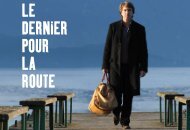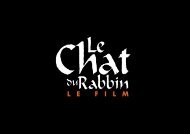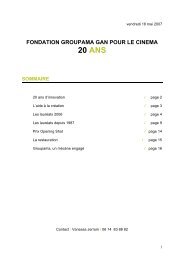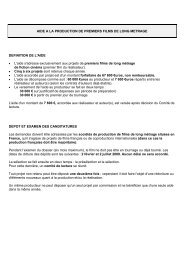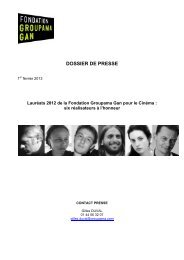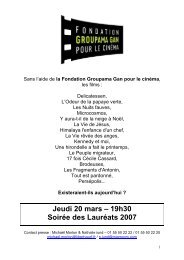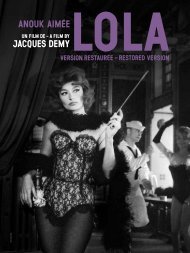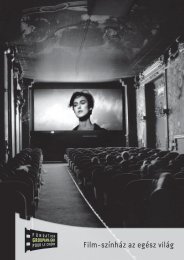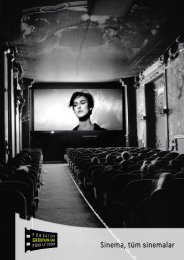Dossier de Presse - Fondation Groupama Gan pour le Cinéma
Dossier de Presse - Fondation Groupama Gan pour le Cinéma
Dossier de Presse - Fondation Groupama Gan pour le Cinéma
- No tags were found...
Create successful ePaper yourself
Turn your PDF publications into a flip-book with our unique Google optimized e-Paper software.
EXE NOUVELLE VAGUE:EXE LES VACANCES 23/04/09 14:47 Page 50world. The background sounds often take prece<strong>de</strong>nce over thedialogue and are often more audib<strong>le</strong>. Such is the case withthe unusual sound of Hulot’s car, a contraption that contrastswith its driver’s discretion. In the <strong>de</strong>scription that Tati gives ofthe car’s effects, we read, for examp<strong>le</strong>, “drives off splutteringfor no obvious reason,” which signals the vehic<strong>le</strong>’s disruptivero<strong>le</strong>.When Tati re-edited his film in the early 60s, he remixedthe sound by eliminating certain dialogue and, inspired byAlain Romans theme music, he produced a new orchestralaccompaniment that was more rhythmic and mo<strong>de</strong>rn thanthe original chamber music soundtrack.In the Polydor Studios in Paris, it was Alain Romans himselfwho played the piano, accompanied by some of the finestjazz musicians in the capital. The muted trumpet, the harpand the brass were replaced by the swing of a ¾ hollow bodye<strong>le</strong>ctric guitar, saxophones and a vibraphone. On this occasion,the pop theme by jazz clarinetist Maxime Saury, “Mon Onc<strong>le</strong>et moi”, recor<strong>de</strong>d two years earlier in Mon Onc<strong>le</strong>, replaced theoriginal music for the scenes in which Hulot listens to the phonograph.In an interview with Le Mon<strong>de</strong> en 1962, Tati said: “So I re-didthe sound – recording quality has consi<strong>de</strong>rably improved sincethen – and I gave the film a more acce<strong>le</strong>rated movement. In1952, we danced slow numbers, holidays followed the rhythmof muted trumpets, today we go from the cha-cha-cha to thetwist, there’s <strong>le</strong>ss waiting, we’re in a hurry.”The soundtrack is as lively and colorful as the film’s manycharacters: a haunting litt<strong>le</strong> phonograph melody for the lonelyhearts,the polyglot hubbub of a restaurant lunch, a cardgame enlivened by a radio newscast, a tennis game refereedby the twitter of birds, a fireworks display with jazz accompaniment...This sound ec<strong>le</strong>cticism recor<strong>de</strong>d on monaural tapeis what we must recapture.The restoration of the soundtrack was based on the soundnegative using the film’s last mix (the 1978 version). L.E.Diapason, a post-production facility specializing in soundrestoration, began by manually eliminating sound <strong>de</strong>fectssuch as the “plops” produced by the numerous splices. Thesound balance was dictated not by the voices (which generallyserve as markers) but by the music because, as is oftenthe case in this film, the voices occupy the same plane as thebackground sounds. In a few si<strong>le</strong>nt scenes, it was particularlyimportant to conserve a slight hiss, thus providing sound texture.Even as it respects the bits of <strong>de</strong>liberately incomprehensib<strong>le</strong>conversation, the film gains in intelligibility.The restored version ofMr Hulot’s HolidayTo restore Mr Hulot’s Holiday is to ensure the continuing availabilityof a film recognized as a landmark in cinema history.Tati’s film vernacular and the silhouette of his heroes provokesmi<strong>le</strong>s among young and adult audiences everywhere.Special care was given to revision of the English subtit<strong>le</strong>s sothat restored film could be seen the world over.Loubna Régragui (<strong>Fondation</strong> Thomson)Hervé Pichard (Cinémathèque française)Philippe Gigot (Les Films <strong>de</strong> Mon Onc<strong>le</strong>)Tom Burton (Technicolor)50



